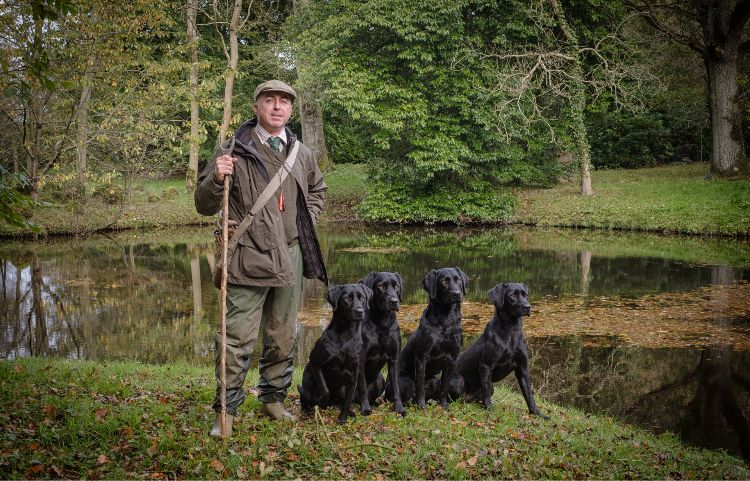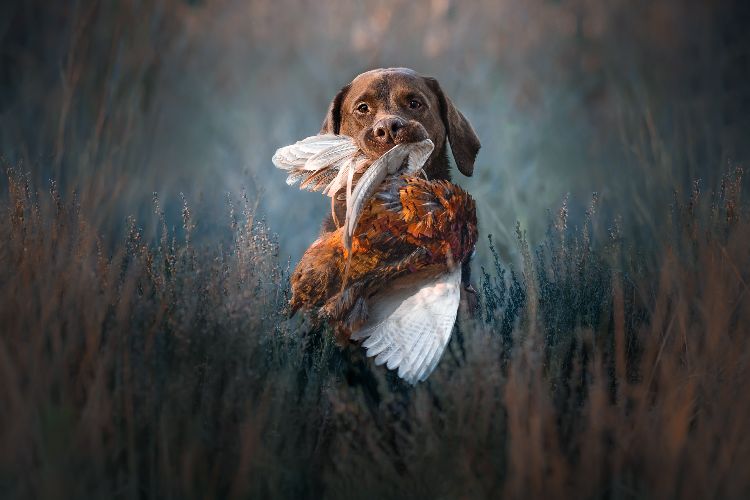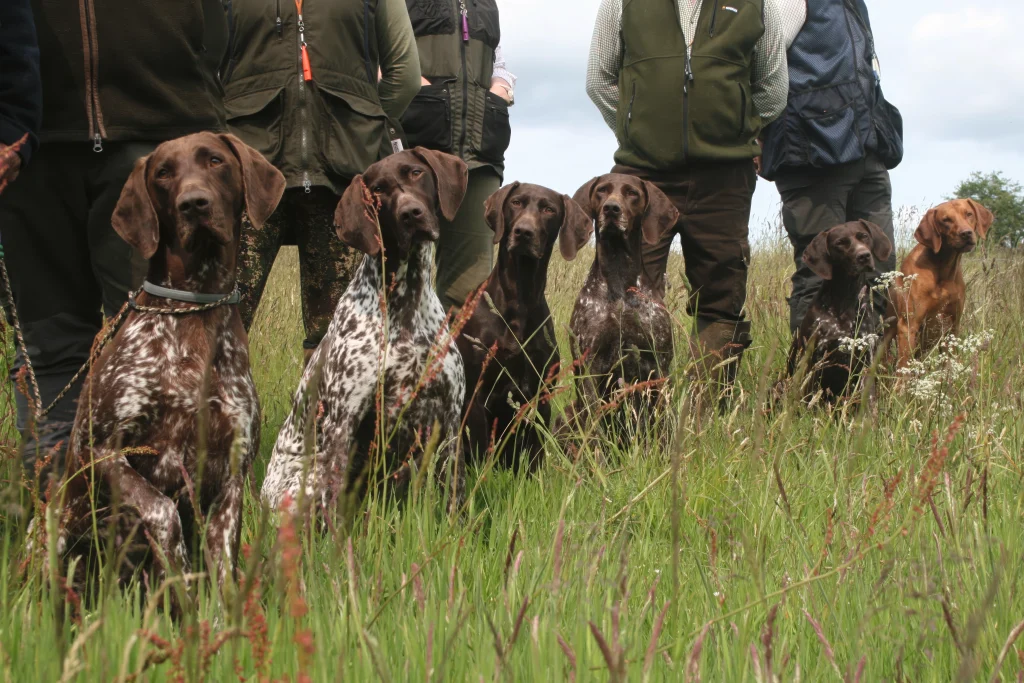Survival guide to picking-up all season
It's a long season for you and your dogs, but Michelle Oseman has drawn on her own extensive experience to compile this guide to getting through it unscathed and enjoying every moment.

With a shooting season that starts in mid-August and continues through to February, we pickers-up face a multitude of weather conditions. The past few years have seen scorching late summers with temperatures soaring and then arctic end of season weather including the infamous ‘Beast from the East’. Whether you are a professional working a large pack of dogs picking-up four or five days a week or someone with a single dog working at the weekends, we need to be able to adapt our circumstances to suit the seasonal conditions. As hardy outdoors folk we need to be prepared for this and also ensure our dogs are appropriately cared for whilst working throughout the season.
Risk management in the early days
At the beginning of the season we may be asking our dogs to pick-up in heatwave conditions, which means ensuring they are fit in advance of the season. This can be difficult when the warm weather is with us through July and August, but early morning and late evening exercise sessions will help to get our dogs and also ourselves fitter. Personally, I don’t believe any pre-season exercise can fully condition our bodies or that of our dogs for the work we are about to undertake. (Ed. Similarly cricket’s greatest bowlers always say the best way to train for fast bowling is fast bowling itself.)
But the better we are prepared, the less difficult the first few days will be. Tired or fatigued dogs make mistakes and are far more likely to get injured themselves. The same must be said for us handlers as well.
Daylight come, daylight go
The one upside to early season shooting is the extended daylight hours tend to mean the day is taken at a more leisurely pace. This allows more recovery time between working spells. As the months move on and daylight dwindles, the pressure starts to mount. Guns want their full day but the available daylight is far shorter than earlier in the season. Keepers are pushed for time to complete their duties as well as ensure the shoot day meets the Guns expectations. The beaters will be dealing with changing weather conditions, drenched maize and long waits whilst the pickers-up perform their tasks.
We will be pushed to get the birds picked, mindful of the keepers’ need to get onto the next drive. All of this can build tension within a shoot day, but if we all stay calm and remember everybody has an important part to play, then we will all enjoy the day.
For the last few seasons here in the Cotswolds we have had to start working our dogs on hard, dry ground with thick summer laden cover. This will be hard work for the dogs and they will probably tire more quickly than in the latter part of the season. They will soon come up to full fitness but the hard ground conditions can lead to strains and sore paws. Keep a close eye on your dogs during the shoot and thoroughly check them at the end of the day. Any injuries dealt with swiftly will aid a quicker recovery. Working on hard terrain like this can be a career limiter for young dogs and a career ender for older dogs.
Unwelcome visitors
Until we get some colder weather you will need to deal with the range of ticks, mites, lice and other creepy crawlies that are likely to be picked up by both dogs and handlers. Using one of the many treatments available to regularly treat your dogs will help, but you should still be vigilant and check your dogs for any ‘friends’ they have acquired over the course of the day. If you are working your dogs on freshly harvested stubble you will need to be mindful of harvest mites until we have had frost on the ground. Also remember we will have to deal with insect bites and the ever-present fear of a wasp nest being disturbed. I always wear insect repellent and long sleeves at the start of the season. My lightweight trousers and gaiters may look a bit over the top in September but have saved me from many bites and stings. I carry a small pill canister on my whistle lanyard and this contains three Piriton tablets. These can be administered to both humans and dogs in the case of stings or bites and will reduce the reaction, but medical advice should be sought as soon as possible.
The other thing to mention during the warm wet weather is the increased risk of Infectious Tracheobronchitis (commonly known as Kennel Cough) breakouts. As an airborne virus, Kennel Cough is spread quickly from one dog to another. Shoots have been shut down with valuable days lost due to the inability to work dogs. If you have any inkling that your dog has been in contact with a dog confirmed to have contracted Kennel Cough, please do not bring it on a shoot day. The 10-14 days you may have to leave your loyal friend at home will save the potential infection of hundreds of dogs.
Port and gin won’t keep you hydrated
Clean, fresh water should be on hand for your dogs at all times throughout the season but especially during the first few months when the weather is warm. Care should be taken to monitor your dogs’ water intake immediately after they finish picking-up on a drive as gulping down litres of water can cause issues such as bloat. I carry about 15 litres of water in my truck on a shoot day. At the beginning of September, the seven dogs I work drink most of that throughout the day so be prepared.
We should also keep ourselves hydrated throughout the day – and apparently port and gin don’t count in the hydration stakes. If you’re picking-up on open ground in full sun it won’t be long before you’ll be feeling the effects. I carry a small bottle of water for myself and the dogs when actually out picking a drive. This can rehydrate either human or canine or be used in an emergency injury situation to wash a wound.
The warm dry weather impacts scent so picking-up during the start of the season can be more difficult. This is when a good mixture of breeds working together can aid a successful day picking-up, but we should also be prepared to keep our eyes peeled as dogs will run over game when scent is really poor. Walk the area you’re picking slowly giving the dogs time to work. Look out for missed game and hand pick if necessary.
Watch out when it’s wet
As we enter the wetter and colder months of October and November other challenges come along. Game may not fly so well on a wet day so we need to be mindful that tired, soggy game may still be walking away from the gun line. Be prepared to hang back before sweeping with your dogs. The majority of trees will have dropped their leaves and this can lead to slippery conditions in wooded areas. Birds may drop into cover and almost seem to disappear into the autumn debris – trust your dog, let it work at its own pace. If there’s game to be found, they will dig it out. Also, many a picker-up has fallen foul of a rabbit hole covered with leaves so tread carefully.
Treat your dog like a racehorse
Throughout the season we ask a lot of our dogs and they give all they can every day. Some days are harder than others and you will need to keep an eye on your dogs’ stamina levels. I have seen very hard working picking-up dogs running around and then all of a sudden collapse with exhaustion. If you think your dog is tiring or starting to run low on energy, stop working it. I am a great fan of the Kronch Pemmikan supplement and give a square to all my working dogs in their shoot day breakfast. I will also use it throughout the day as required if I feel a dog is lacking energy. It’s a quick way to boost them in between drives or over an extended lunch break.
I also have drying coats for my dogs which I will use as required. If we stop for lunch on a wet cold shoot day, I will rug the dogs up so that they can dry and be kept warm. Keeping warm and drying off can use a huge amount of energy for a dog and a coat will reduce this energy drain. I will also rug the dogs up for the journey home so when we get back to the kennel, they are mostly dry and can be groomed, fed and put to bed to be ready for the next day. Our dogs, when working, are as athletic as a racehorse and no jockey would fail to rug their horse up after a race. Why would we not preserve our dogs’ fitness and health in a similar manner?
The mobile wardrobe
My truck is a mobile wardrobe. I carry lightweight coats, waterproof coats, warm coats, extra gilets, extra jumpers, wide-brimmed hats, woolly hats, waterproof leggings and even a complete new set of clothes for the inevitable day when I get soaked to the skin. The weather can present four seasons in one day (credit to Crowded House) so, although this may seem over the top, it has allowed me to be appropriately attired whatever the changing weather throws at us on a shoot day. It also operates as a clothing bank for other shoot members when their faithful 10-year-old coat suddenly starts to leak!
Although food and drink may be provided by the shoot on the day, I always bring some food, water or a flask of coffee so I can eat when I need to. Although the Guns may stop for elevenses, this is when we pickers-up are out collecting from the last drive. On a busy shoot day, we may not get a mid-morning break or even lunch even if a bite to eat or drink is provided. Just as we would hydrate and fuel our dogs, we need to keep our energy levels up as well.
The deep midwinter
The final months of December and January bring the complication for both man and beast of ice and snow. Although the sight of an iced-over pond set within a frost framed landscape may look beautiful, it can hide many dangers. The ice may not hold the weight of your dog as it gallops over to retrieve the game lying on top. Very quickly a dog can be lost under ice so you need to seriously consider whether the retrieval of that bird is worth the potential risk. Broken ice has the ability to slice as much as a sharp knife. I’ve seen dogs badly cut by ice shards from puddles let alone a
large body of water. Even free flowing rivers can be deceptive once the really cold water starts to flow. The shock of jumping into such cold water can paralyze your dog or even worse!
Picking-up in snow is challenging as birds drop into deep snow and can quickly be covered by fresh falling snow. Scent is not good at all. There is also the human risk to consider. Make sure you know the terrain before venturing out in a vehicle or on foot.
Be ready to adapt
A tip I picked up from an old friend was to carry a flask of warm water in snowy weather – spaniels and longer haired dogs suffer with snow and ice collecting on their coats and between their toes. It can be very uncomfortable and limits movement. Soak a towel in the warm water and use it to melt the ice or snow balled up on the dog after every picking-up session.
As with everything in life, the key to ensuring a safe and enjoyable shooting season is to be adaptable to the environment and elements. Weather conditions such as wind direction, snow and ice will dictate a shoot day and this may well change throughout the day as the weather unfolds. Being prepared and adapting as required should ensure a great day of sport for all involved.
Related Articles
Get the latest news delivered direct to your door
Subscribe to Gundog Journal
Unlock the full potential of your working dog with a subscription to Gundog Journal, the UK’s only dedicated magazine for gundog enthusiasts. Published bi-monthly, this authoritative resource delivers expert training advice, in-depth interviews with top trainers and veterinary guidance to help you nurture a stronger bond with your dog.
With stunning photography and thought-provoking content, Gundog Journal is your essential guide to understanding, training and celebrating your working dog.
Save 10% on shop price when you subscribe, with a choice of packages that work for you. Choose from Print & Digital or Digital only with each journal delivered directly to your door or via the app every other month, plus access to past issues with the digital back issue library.









